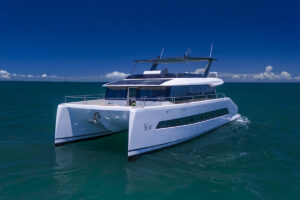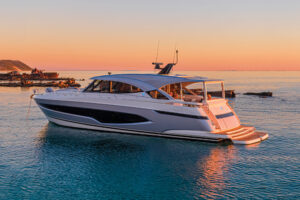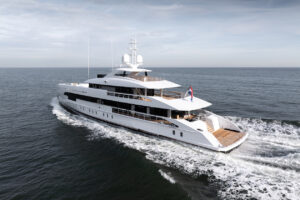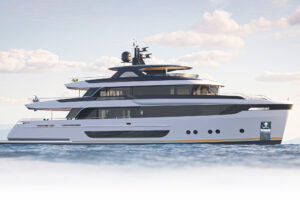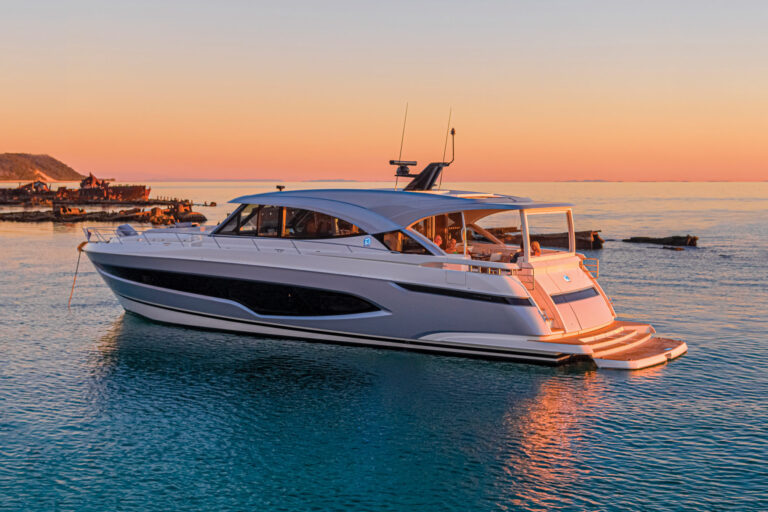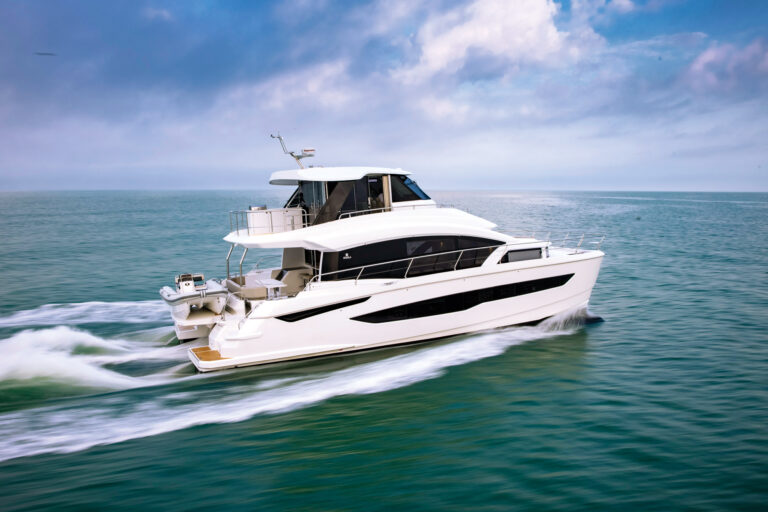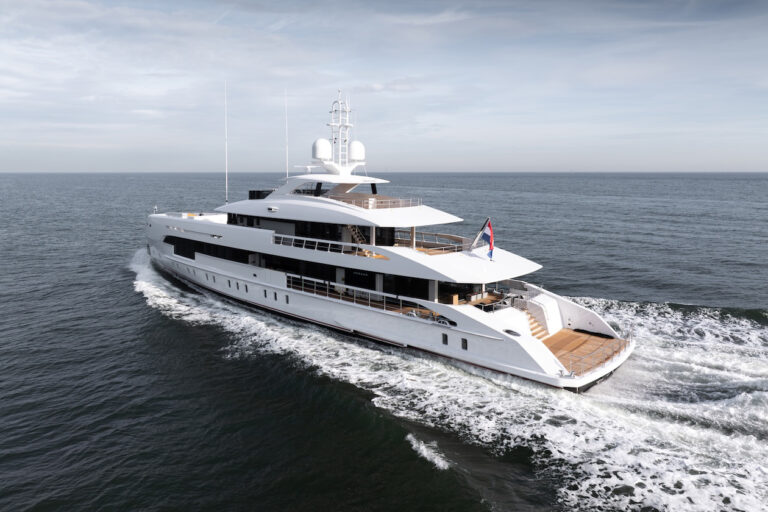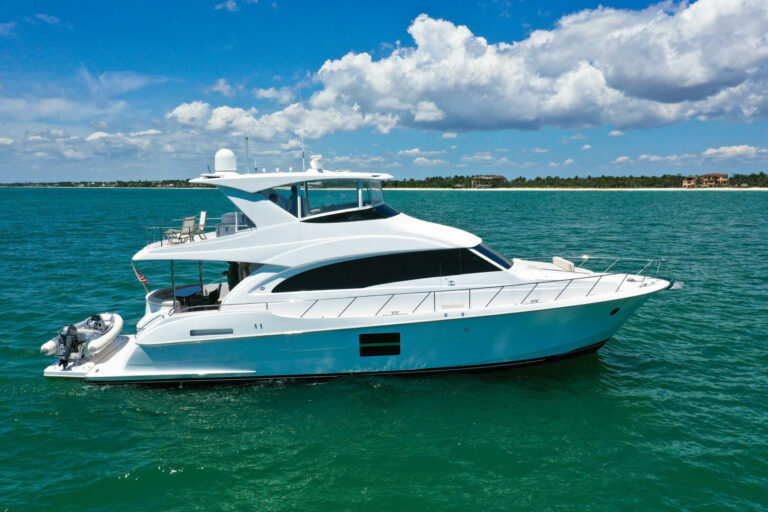Back in the mid-1970s, a wave of funky Taiwanese sailing and power craft began invading U.S. shores. This wide range of vessels came complete with images of dragons and serpents inlaid in bulkheads, loads of teak, and bad wiring, earning them the designation of “teaky leakies. They often required extensive reworking upon their arrival in the states. Over time, however, the higher-quality Taiwanese yards rose to the surface, and their marketing motto changed from, “You get a lot of boat for your money”, to “You get a lot of quality for your money.”
The level of quality now coming out of Taiwan is on par with and often better than that of many North American and European yards. Taiwanese yards, however, lately have been losing their competitive edge on price point. Labor wages have climbed in developing Taiwan, which, with the high cost of shipping to the United States, almost eliminate any cost advantage. As a result, quite a few enterprising Taiwanese yards have headed to mainland China, where labor rates are lower, and yards, with government incentives, can continue building boats at a reasonable cost.
Hampton Yachts is a perfect example. Jeff Chen, chairman of Hampton Yachts and the builder of the new 550 Pilothouse, comes from a long line of boatbuilders. His family founded the Formosa yard, arguably the largest yard in Taiwan during its heyday. Today, he resides in Shanghai, China, where he oversees Hampton. “Because of our lower labor rate, we’re able to put more into each yacht, with more attention to detail, said Chen, explaining the move.
This statement is reflected in the new Hampton 550 Pilothouse, a design based on the Hampton 490 Pilothouse. If your plans call for extended cruising, but you don’t want to spend upwards of a million bucks, the Hampton 550 Pilothouse may be worth checking out.
The interior layout should certainly satisfy cruising families. Her raised-pilothouse design offers divided living space and the benefit of a lower station. I must say, since spending a week in the Virgin Islands aboard a 42-foot pilothouse design, I’ve become a huge fan of the concept.
The Hampton 550’s pilothouse includes all the features I came to appreciate during my cruise. The raised pilothouse settee offers a commanding view forward. Not only is this a good spot for sitting back and navigating with an autopilot remote, it can serve as a kind of “second saloon. If I were going to order the 550, I would specify a table slightly larger than the one on our test boat, one with enough surface area for at least two people to dine. The settee cranks out to form a comfortable berth.
The line of sight from the lower helm forward is good, though close-quarters maneuvering would be best handled on the flying bridge or aft station. Two pantograph side-opening doors demonstrate Hampton’s ability to go the extra mile. Sliding side doors, no matter how well they are executed, are often a source of leaks. The 550’s solid doors provide an airtight seal. Opening the two at anchor will provide refreshing cross-ventilation.
The saloon area was laid out using a template that seems the norm for the raised pilothouse. There is a properly equipped U-shape galley that benefits from good use of space. Appliances are American-made, and Hampton’s East Coast dealer, Anchor Yacht Sales, provides owners with some latitude in selecting them. For those planning to head out for island or Mexican cruising, the 550 should have enough room for several months’ worth of dry stores. A glass cabinet rounds out the end of the counter unit.
The saloon layout is functional, with an L-shape settee to starboard and a split settee arrangement opposite. The stainless-steel framed sliding door to the afterdeck is flawlessly welded. My only gripe with the arrangement is the placement of the settee. It’s well oriented to the galley area, making conversation between the cook and guests in the settee easy. My preference, however, is to orient the primary lounging space with respect to the outdoor living space. This can be arranged with Hampton.
“The yard isn’t very limited in terms of what they can’t do”, said Forest Roberts, president of Anchor Yacht Sales, as he took me through his demonstrator. “The cooperation between the yard and the dealer is very good.”
This is important when building a boat overseas. If the factory is unresponsive, the dealer becomes stuck in the middle, and the customer ultimately becomes frustrated. To help with this, Hampton has an office in Newport Beach, California, headed by the company’s president, Patrick Chen. Patrick and Jeff’s enthusiasm was contagious, and their deliberate, careful plans for growing the 12-year-old company should ensure it remains a long-term player in the market.
Hampton offers a standard two-stateroom layout and an optional three-stateroom layout. The three-stateroom layout may appeal to Hampton’s strong European customer base, but it seems a little tight for Americans, with their quest for plushy comfort. Our test boat’s two-stateroom arrangement had staterooms of almost equal size, with en suite heads. Both staterooms have queen island berths. In the amidships master, the berth is flanked by two rows of bookshelves and nightstands. If this were my yacht, I would be inclined to use the forward guest stateroom as the master, taking advantage of the air and light from an overhead hatch.
Compared with that of some other yachts in this size range, the lower deck area is a bit pinched by the 15-foot, 6-inch beam. This is a trade-off. On one hand, the beam-to-length ratio means less horsepower is needed to push the boat through the water, but the nip and tuck may seem a compromise to some.
The entire interior is finished with high-gloss cherry. Burl inlay accents the smooth joinery, and cabinets and drawers are nicely finished.
The flying bridge layout is tough to beat. Access is from the afterdeck or through the pilothouse. The helmsman has a good line of sight around the yacht. Backing down is a little tricky, especially if the tender is stowed on the deck, but the third station on our test boat more or less negated that.
Electronic placement might be a bit difficult-units most likely will need mount-on brackets. Not only can this be unsightly, especially on a 55-foot yacht, but the exposed backs offer an opportunity for salt water to find its way to the connections. Since all-in-one radar and plotter components have become so good, though, the reworking needed should not be insurmountable.
The seating arrangement on the bridge works well. A double bench-style helm seat serves the helm, and a straight settee is opposite. The L-shape settee abaft the straight settee will offer the perfect spot to toss back a few appetizers after a day of cruising. A fiberglass wet bar with optional ice maker is abaft the helm area. The tender can be stowed in a fore and aft orientation.
The engineroom reflects the company’s emphasis on U.S. components. The twin 480 hp Cummins 480C-E diesels are a good match for the 550. These were coupled with Tides Marine dripless shaft seals, serving Aquamet 22 stainless-steel shafts. Fuel tanks are fiberglass, and water tanks are stainless steel. (Water from stainless-steel tanks tastes better than water from fiberglass tanks.) A backup air-conditioning pump comes on line with the flick of a switch. Anyone who has had to prime a pump or clean out a filter at 3 a.m. will appreciate this detail.
The 550’s semi-displacement hull has a very fine sharp entry reminiscent of the older Tollycrafts. This transitions to a wide reverse chine that provides the surface for the 550 to plane, as her bow lifts. An advantage of a semi-displacement hull is its ability to reach higher speeds if needed, as well as operate efficiently at slower speeds, if range is required. The moderate keel of the 550 provides an easy tracking hull at slower speeds and offers added protection in case of grounding.
Though we reached a top speed of 22.8 knots with the 550 lightly loaded, her sweet spot seemed to be around the 17-knot point. If a few long legs are planned, you can back her down to a respectable 11 knots while burning only 4.5 gallons of fuel per hour for each engine. If you allow for a 10-
percent reserve and generator running time, the 550 should have a range of about 800 nautical miles. On our test boat, which was still being commissioned, we had a misbehaving autopilot pump that sucked hydraulic fluid from the steering. (This was installed stateside.) Therefore, conditions did not permit me to finish maneuvering her. The company bent over backward to get us back on board after the test, but scheduling conflicts prevented it. Before our mishap, however, the 550 demonstrated a fairly dry ride, with water cast aside by the reverse chine forward. She tracked well and true.
Sure, the 550 has a few areas that might need improvement, and the Hampton name may be unfamiliar to some in the yachting populous (making it tough to assess its resale market). But Hampton Yachts and its knowledgeable dealers are focused on the company’s growth and the betterment of its products. Are similarly styled, more expensive yachts worth the higher price tag? That depends on what you need and how you want to cruise. If the Hampton 550 Pilothouse is any indication, though, this next generation of Taiwanese boatbuilders is moving at warp speed to make a lasting impression on the U.S. market.
Contact: Hampton Yachts U.S.A., (949) 673-6300; www.hamptonyacht.com.

